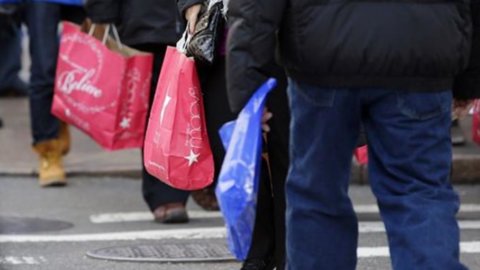The increase in consumption in the current year (+0.5%, at constant prices) should be supported by the improvement in disposable income, estimated to reverse the trend after six consecutive years of decline, also thanks to the tax bonus.
On average for the year, internal consumption could therefore recover a path of growth, both in real and nominal terms, mainly due to the increase in the consumption of non-food goods, driven in particular by the start of a new cycle of durables and by the slow continuation of the tertiarization process, which will allow services to further increase their incidence on the household spending basket.
On the other hand, food consumption will remain in negative territory, reflecting consumer behavior aimed at rationalizing and reducing waste, but also the persistence of material difficulties of less well-off families, who will have marginal benefits from the personal income tax credit.
The personal income tax bonus is decisive for this result
9.7 million families, ie about 40% of Italian families, will receive at least one tax bonus in 2014; on average these families will receive a credit of 655 euros between May and December, for a total amount of the bonus estimated at around 6.4 billion euros, based on the microsimulation model used.
To assess and estimate the amount of the bonus that households could allocate to consumer spending in 2014 and the potential impact on the various spending markets, we assumed that the Irpef bonus is a one-off, therefore not involving a permanent change in income , and that the allocation of additional resources takes place without changes in the propensity to consume and in the specific expenditure basket of households according to the income bracket to which they belong.
Based on our estimates, 85% of the total amount of the bonus, i.e. 5.4 billion euros, could be used for consumer spending, while the remaining 15% was used for savings or other uses (payment of mortgages, loans, etc. .). the bonus will mainly go towards non-compressible goods and services (from food to housing costs), which have a significant impact on the spending budget of families, especially those in the lower income classes, and to a lesser extent towards voluptuous markets, heavily sacrificed with the crisis, as in the case of clothing and footwear.
However, it is necessary to consider how the simultaneous increase in indirect taxes in the current year (due to the increase imposed by current legislation, including higher property taxes) could dampen the effect of the tax bonus on consumption. Furthermore, if the tax credit is not a one-off, but permanent, then the impact of the bonus could also vary greatly, both in terms of uses other than consumption (savings, mortgage payments, loans, etc.), and in terms of allocation in the various expenditure items (depending, for example, on the average unit value of the goods and services to be purchased, on the need for replacement, etc.).
The progressive improvement in disposable income will allow domestic consumption to continue its slow recovery (just over 1% on average for the year) also in the two-year period 2015-'16.
A limited dynamic, which will also be affected by the trend towards the accumulation of savings and the persistence of critical situations in the labor market. Broadening our gaze to the levels of consumption at the end of 2016, it also becomes evident that consumer behaviour, once the crisis is over, will no longer be the same as before.
The duration, intensity and pervasiveness of the crisis have led many families not only to great sacrifices, but also to strategies for saving and reducing waste that will hardly be abandoned in the next few years, preventing many markets from recovering to pre-crisis levels.
Furthermore, the evolution of individual sectors in the next few years will continue to be conditioned by the cost of goods and services that are not easily compressible, which, given a supply system that is still not very competitive, will continue to drain resources. To these will be added those for expenses for treatment for the future (medical and health expenses, social protection, financial services), given the impact of the restrictive measures adopted in Italy in recent years, in particular those relating to the containment of healthcare expenditure and public pension.
Among the various markets analysed, the food and clothing and footwear sectors could remain at levels more than 10% lower than in 2007, incorporating the consolidation of consumer behavior oriented towards private labels, promotional products and brands/ low cost channels, which are in any case able to guarantee a good quality level and service content.
The mobility market will maintain decidedly low volumes, within which the demand for means of transport could remain at levels almost 40% lower than in 2007, compatible with a further shift towards alternative types of transport to the use of the private vehicle.
On the other hand, the outsourcing process will continue which will allow services, over the next two years, to further increase their incidence on the household spending basket; however, this process seems to be fueled above all by the growing divergence of lifestyles and consumption habits between different income brackets rather than by a physiological trend; a factor which is also supporting a progressive polarization of consumption.





